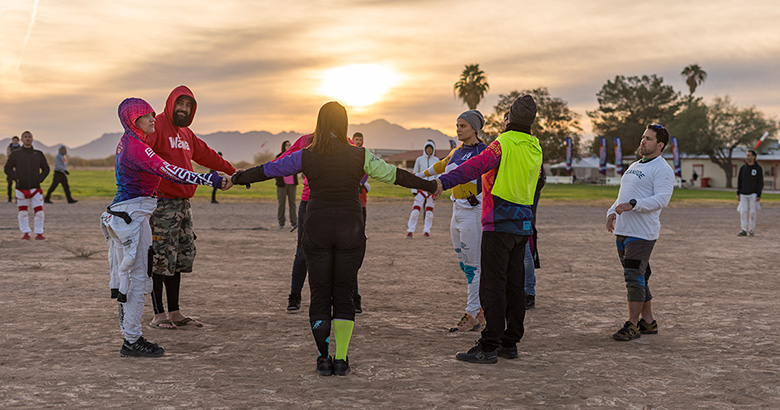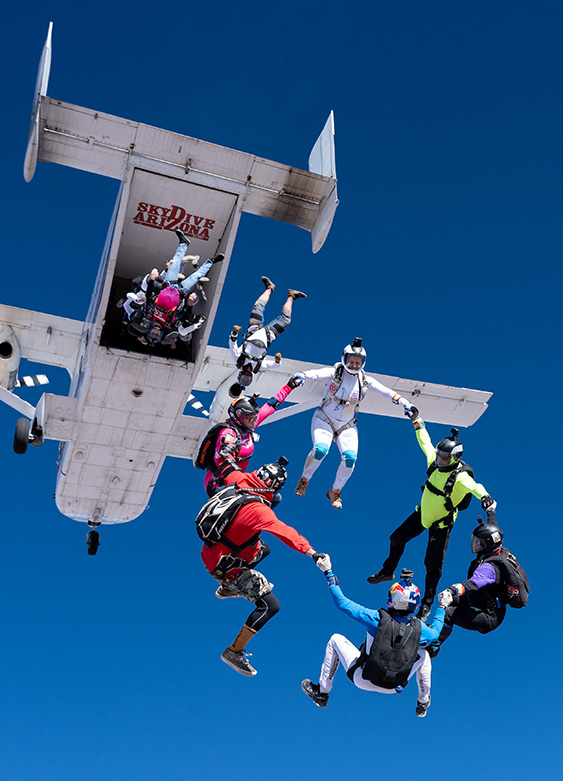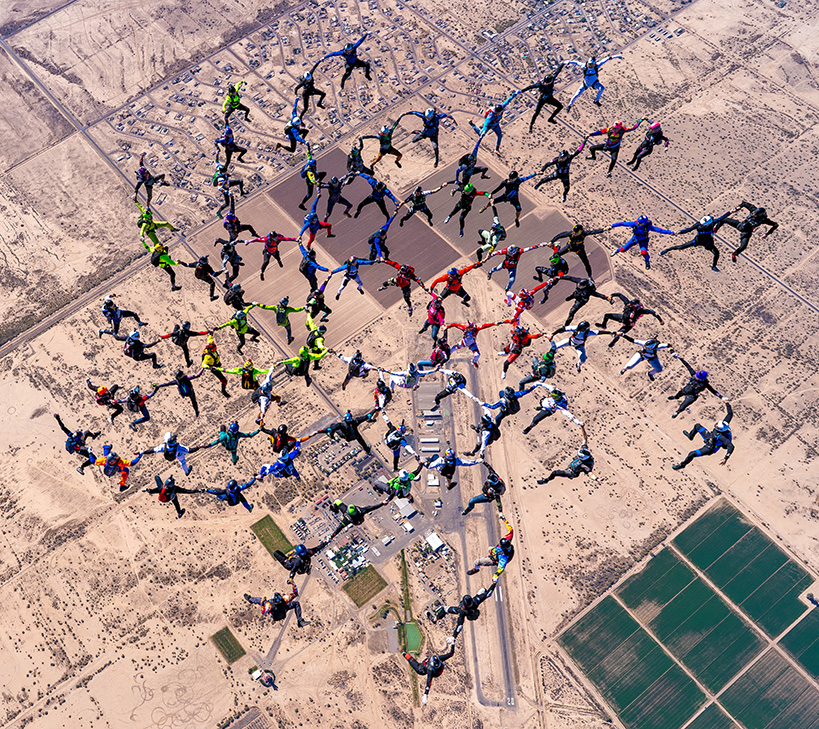At the end of November, a team of skydivers from 26 countries assembled at Skydive Arizona in Eloy for Stand Together, an event that set a new head-up world record and continued the ambitious (and still elusive) quest to build a triple-digit-sized head-up formation. Led by Amy Chmelecki and Sara Curtis of Broken Records LLC, the team made three 40-way-core jumps and 16 100-plus-way record attempts from five planes before making the difficult decision to reduce the team size to 96 skydivers on the third-to-last attempt. This attempt was successful and, pending ratification, broke the previous 84-way Fédération Aéronautique Internationale World Record for Largest Head-Up Formation. The group then made two final attempts at 100 skydivers.
This new world record underscores just how difficult it is to fly head-up formations, especially when compared to belly and head-down formations, which have both long ago achieved triple-digit sizes. Consequently, the aspirational endeavor of moving the big-way-head-up discipline forward requires weaving an intricate tapestry from many critical threads.

Photo by Ewan Cowie.
Exploring the Threads
One of the main threads to a successful head-up formation is finding the people who are best qualified, available and willing to fly it. To do so, the organizers held record camps across the globe, including in the USA, Europe, Australia, South America and the Middle East. These training and selection camps sought out the best-of-the-best head-up flyers by building formations ranging in size from 20 to 45 people and offering those who displayed the highest of talents an invitation to join the main event.
Another key thread was the engineering of the formation. Past head-up records used pods–five-person partial rounds that form on the base or another pod. However, connecting those pods with bridges to stiffen the formation created burbles and other complications. Without the support of bridges, the ability to build up to and beyond 100 people dramatically reduced and waves in the formation often caused sections to crumble. The 84-way in 2019 built on a 12-way base, avoiding bridges and allowing for more pods to simultaneously build, but the base created its own challenges and was often unstable; breaks or collapses occurred on many of the attempts.
 Photo by Seth Robison.
Photo by Seth Robison.Moving back to a more traditional and stable 8-way base for the latest attempts required a different type of engineering to improve chances for success. The organizers chose to experiment with a new, hybrid style of build, where the pod-and-bridge style builds as a “daisy,” with all right-hand stingers on the base and petals instead of pods. A simultaneous build of each petal required precision flying and was very challenging but did seem to have a higher degree of success. The inner circle of flyers consisted of 40 people, with the outer 60-ish people building as whacker lines, a page borrowed from the approach formation skydivers used to engineer the outer sections of the 400-way FS world record in 2006. Formation skydivers have often used this approach since then, and Matt Fry and Andy Malchiodi–supporting organizers at this event–had heavily experimented with it at numerous high-profile head-down events. This build requires better individual flying technique, as no one can simply hold on for the ride. Flying upright has also not yet advanced to the point of using “pre-builds” like in belly formation skydiving, where the whacker lines build independently of the formation, then dock on it as a unit.
Another thread developed from a trick derived from the recent women’s world record events at Skydive Arizona: Those in the whacker lines trained in the on-site wind tunnel the first day of the event to help get jumpers up to speed and ready to fly as precisely as possible while the 40-way core of fliers trained in the air. This helped significantly with getting the whole team up to speed quickly.
Finally, a thread that made the event possible was the funding and hosting assistance of various entities. Skydive Arizona provided five aircraft and pilots, one onsite and two offsite judges, four camera fliers, numerous debriefing rooms, lots of support staff and, of course, the spacious drop zone. Funding for the event was also noteworthy, with The Women’s Skydiving Network serving as the title sponsor and Rush Refrigeration sponsoring the entire cost of the final 100-way attempt.
Standing Together by the Numbers
The theme of the event, Stand Together, leaned into the idea that in an ever-evolving and politically divided world, skydivers can put aside those differences and come together to achieve great things as a team. This event quite literally brought in a world of talent, as the jumpers represented 26 countries, including Argentina, Australia, Brazil, Canada, Colombia, Costa Rica, France, Germany, India, Israel, Italy, Kuwait, Ireland, Mexico, Netherlands, New Zealand, Paraguay, Poland, Scotland, South Africa, Switzerland, Turkey, United Arab Emirates, United Kingdom, United States and Venezuela.
The 8-way base of the record formation had a symbolic 50/50 split of men and women. This happenstance detail was also symbolic of how far skydiving has come in growing the balance of men and women in the sport. “We never would have sacrificed the greater good to have the base 50/50, but it was easy to pull off [with the talent available] and something that has never been done before,” Chmelecki mentioned.
Also notable was the parity of men and women organizers. Supporting Chmelecki and Curtis were Fry, Domi Kiger, Luis Adolfo Lopez-Mendez, Malcholdi, Jason Russell and Steph Strange, who took the lead in debriefing sectors of the formation, reviewing footage with the participants to provide feedback on technique and safety.
Getting to 100
The path to setting a 100-plus-person record has been a lofty goal for more than nine years, ever since jumpers built a 52-person formation at Skydive Arizona in 2015. That event was the spark.
“To our surprise, we got [it] that year. We realized the 100-way was possible, and we thought it would be possible to do it sooner … so we planned to do another record event in 2016, with hopes of getting a 100-way. We had terrible weather during that event and ended up with a 72-way record, which—all things considered—was a huge accomplishment. Then we tried for the 100-ways again [in] 2019 at SDC [Skydive Chicago in Ottawa, Illinois]. We got very close on so many jumps, but that 12-way base kept having problems, and we ended up with an 84-way,” Chmelecki asserted.
So, in the latest effort, when 111 head-up flyers jumped 10 times, the largest head-up record ever attempted, followed by another nine attempts with 100 people, it cemented the fact that building a triple-digit head-up record is possible and there for the taking.

Photo by Nathan Roth.
What’s in a Number, Anyway?
“It’s just a number. Who cares, really? I’m here to set a new record,” one skydiver responded to a question of which was more important: “triple-digit record or bust” or “concede to another double-digit world record.” Sentiment was mixed. A lot of jumpers had their sights set on just getting a record in the books, regardless of number, while others were more hopeful to add a third number to the head-up record books. Chmelecki summed it up when she addressed the group about the 100-way: “It’s such a sexy number.”
But it does pose the question: Does the 100-way really matter? The answer to that is, of course, subjective. There does seem to be an underlying, almost unspoken, goal among the greater community, an arbitrary line in the sand to set a head-up record with triple digits. John F. Kennedy’s speech about going to the moon resonates: The jumpers chose this 100-way collective goal not because it’s easy, but because it’s hard. They chose to shoot for 100 because the goal serves to organize and measure the abilities and skills of advanced skydivers and to demonstrate what can be accomplished as a team in the head-up discipline.
This event and this team got so close to building a 100-person record formation. But setting a 96-person world record is no easy endeavor and quite an accomplishment itself. The esprit de corps of an entire team of 111 from across the globe will inspire the next batch of jumpers to aim even higher and to continue standing together to accomplish great things. That is something to be quite proud of.
 About the Author
About the Author
Ryan Sass, D-31681, calls Skydive California in Tracy his home drop zone. This head-up record marked his 14th world record and the completion of more than 100 jumps with 100-plus people during his 185-consecutive-month skydiving avocation. He wrote this article in loving tribute to his father, Forrest Lee Sass, and Steve Curtis’ father, Danny Lee Curtis, who have both encouraged their sons’ skydiving aspirations.